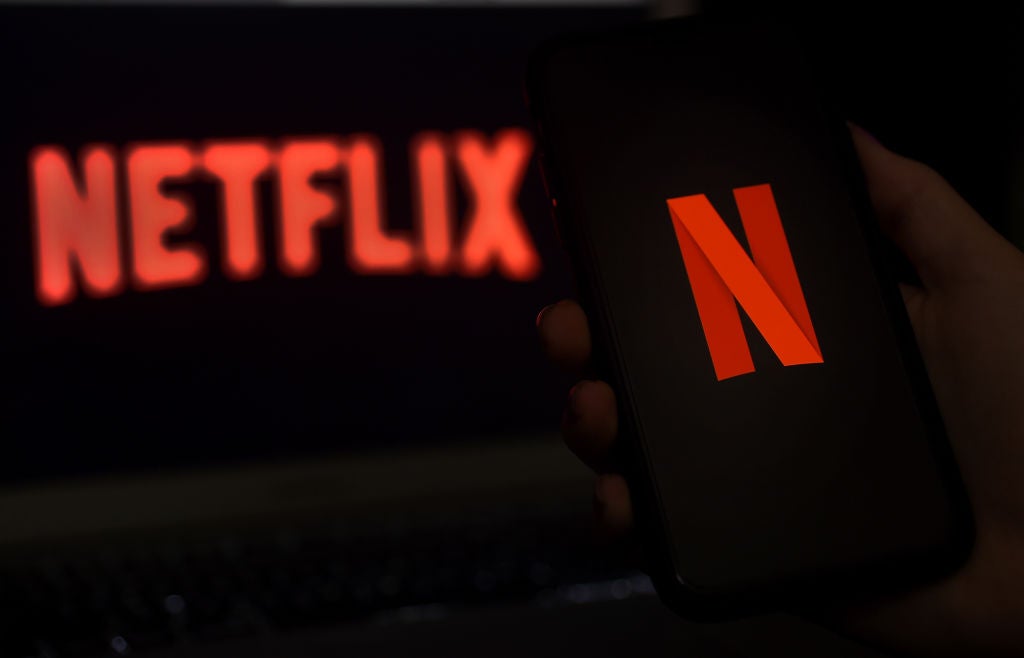Netflix promises to wipe carbon footprint in under two years
The streaming giant has come from behind with a promise to achieve net-zero emissions by the end of 2022. Senior climate correspondent Louise Boyle explores the plan


Netflix today announced a target of net-zero emissions by the end of 2022.
The streaming giant made the pledge on Tuesday in its “Environmental Social Governance” (ESG) Report 2020, on the three widely-accepted areas that illustrate a company’s impact on society.
Emma Stewart, Netflix’s first sustainability officer, told The Independent: “We fully anticipate that we’ll be able to hit this target despite it looming on the horizon.”
The company report also revealed that Netflix’s carbon footprint was 1.1 million metric tons (MT) in 2020, equivalent to a city with about 150,000 homes. The company’s footprint declined from 2019, mostly due to delayed filming because of the Covid pandemic.
The company says that 50 per cent of its footprint comes from making film and TV, followed by corporate operations (40%). Streaming content, via data centre providers, accounts for 5 per cent of emissions.
Read more:
- Can Saudi Arabia, the world’s second largest oil producer, become a global force tackling the climate crisis?
- Majority of economists say benefits of reaching net zero by 2050 outweigh costs, survey finds
- Greta Thunberg takes aim at global trade emissions in Suez Canal meme
- How is bitcoin fuelling climate change?
Netflix, which reported revenue of $6.6billion last quarter, has around 204 million subscribers worldwide.
The company’s emissions goal is in line with science-based targets of the Paris Agreement. The company says that it aims to bring the “remainder to zero through projects that remove carbon from the atmosphere”.
The United Nations is encouraging the spread of net-zero commitments to give the world a chance of curbing global heating to 1.5C, above preindustrial levels, and avoid climate catastrophe.
The streaming giant has been slow to set a net-zero target compared to fellow tech companies. Microsoft announced a plan to be carbon negative by 2030 more than a year ago. Soon after that, Facebook committed to reaching net zero within the decade and Apple pledged to be 100 per cent carbon neutral across supply chain and products by 2030.
“We are a little late to setting a climate target, we are fully conscious of that,” Ms Stewart, who joined Netflix in October, conceded.
“However what I’ve learned since joining this company is that when it decides to do something, it does it well and does it fast. We’ve accomplished more in the six months I’ve spent here than I’ve seen in years at other institutions.”
One in five of the world’s 2,000 largest publicly-listed companies have now committed to a “net-zero” emissions target. But environmentalists have expressed serious scepticism about goals set for decades in the future.
Committing to net-zero in under two years is potentially risky but it’s unlikely that a company as shrewd as Netflix would do so without being certain that it is well within bounds.
And not all carbon footprints are alike, with some companies facing much larger challenges. By comparison Microsoft, reported 16 million MT of carbon emissions in 2020.
So how does Netflix plan to do it? The plan is to “Reduce, Retain, and Remove Carbon” along with plowing investment into nature-based projects.
But firstly, it warrants a look at just what emissions Netflix is talking about. The climate target includes all direct and indirect emissions produced by the streaming platform, called “Scope 1”, “Scope 2” and and “Scope 3”, like those from its corporate headquarters and studio facilities it owns.
The company says it will reduce Scope 1 and 2 emissions by 45 per cent by 2030 by installing solar panels and switching to renewables.
It will also uses its significant influence over long-term corporate office leases, transportation and building materials vendors. The company leases 95 per cent of office and stage space, and intends to encourage landlords to deploy on-site renewables and take green power options from utilities.
Other tactics for reducing emissions, according to Netflix’s ESG Report 2020, include hiring local crew to avoid travel and lodging, and providing “employee commuting options”.
At production states, they intend to install clean and silent mobile battery units over diesel generators, and offer free charging stations and parking for electric vehicles.
The company says that it will count all “relevant” Scope 3 categories, with the aim of having a “positive ripple effect across the industry”.
This means emissions for all Netflix content whether its own production, for example last year’s sci-fi movie The Midnight Sky starring George Clooney, or a third-party production, like Our Planet or Bill Nye Saves the World. It also includes licensed content that is Netflix-branded like the feature documentaries, My Octopus Teacher or An Inconvenient Sequel.
Ms Stewart said that while greenhouse gas (GHG) accounting guidelines would class these emissions, from licensed productions, as belonging to someone else, “we’re voluntarily taking responsibility”.
Scope 3 emissions will also include those associated with corporate and production purchased goods and services, employee commuting and business travel.
“The more decarbonisation we can find, in our own managed productions, the better off our partners are, so why not look at the whole thing at once?” she said. “An example is with LED lighting on set [which] is 75 per cent more efficient than incandescent lighting. At first productions were a little wary, as lighting is really important to high-quality filming.
“What we’ve found is that because it’s 75 per cent more efficient, it produces less heat, which means we don’t need to cool the space which leads to further emissions reduction. And lo and behold, the makeup doesn’t melt quite so much so all of the talent are very happy.”
She added: “We’re hoping to do the same around electrifying the vehicles on set. Medium duty and heavy duty electric vehicles are largely not available right now and so we want to work with our vendors to grow the supply to the benefit of us and others in production.”
The sustainability chief said that while the company’s emissions data had not reached the granular level for which show produced the most emissions, “we will get there”.
To deliver its streaming service, Netflix uses cloud providers like Amazon Web Services (AWS) and Equinix, and is including their emissions in targets.
Netflix provides Open Connect Appliances, basically a system of mega hard-drives, to Internet Service Providers free of charge to improve efficiency, the company says. This means if you’re bingeing Bridgerton in London, it will be streamed from a nearby location in the UK and not from Netflix’s California HQ.
What isn’t include in those Scope 3 emissions is those created by subscribers streaming shows on their phones, tablets or TVs.
However Netflix has joined with other industry heavyweights like the BBC, Sky and ITV to partly-fund an online tool called DIMPACT, developed by a team at the University of Bristol, to measure emissions of video streaming, as well as for other internet uses like publishing and advertising.
From the data, Netflix estimates one hour of streaming on Netflix in 2020 to be well under 100g CO2 equivalent (emissions from all greenhouse gases, not just CO2), equivalent to driving a gas-powered car about one-quarter of a mile (400 meters).
Additionally, the Netflix report says that by the end of year, “any emissions we cannot reduce internally will be addressed through investment in high quality climate action projects”, which prevent carbon from entering the atmosphere, such as conservation of at-risk tropical forests to retain existing carbon stocks.
Among the projects are Lightning Creek Ranch in Oregon, the US’s largest bunchgrass prairie, and Darkwoods Forest Carbon Project in British Columbia, a temperate rainforest that provides habitat for numerous species, including grizzly bears and wolverine.
It is also investing in Kenya’s Kasigau Corridor REDD+ Project to protect half a million acres of dryland forest and more than 300 threatened or endangered species, including 11,000 elephants.
Netflix will report emissions using the “Internet & Media Services” and “Media & Entertainment” frameworks from the nonprofit, Sustainability Accounting Standards Board (SASB), which has established ESG disclosure standards for an array of industries.
While SASB disclosures are currently on a voluntary basis, the US Securities and Exchange Commission (SEC) this month formed an ESG enforcement task force, stepping up its focus on climate in line with the Biden administration’s aggressive approach to the crisis.
Part of the focus of the SEC’s 22-person team will be disclosures from public companies related to climate change. The agency has also launched an effort to update guidance for public companies on how they share information with investors on climate risk and made the topic a priority for 2021 examinations.
A report last week by the Energy and Climate Intelligence Unit (ECIU) and Oxford Net Zero, revealed many net-zero targets are yet to be backed up by transparent and robust steps needed to reach net zero. There are growing concerns that businesses could be announcing climate action but not following up with concrete changes – a practice known as “greenwashing”.
“We’ve had a massive number of entities setting targets over the last few years, but of course a target on its own isn’t going to reduce emissions,” said Richard Black, the report’s lead author.
The report found that only 20 per cent of targets by governments and companies meet the basic criteria for credible net-zero plans set out by the UN-backed “Race to Zero” campaign. They include defining interim measures and targets, starting to take action immediately and publishing progress reports.
Co-author Thomas Hale, from the University of Oxford, warned that companies and countries cannot simply rely on buying carbon offsets to reach net zero.
“The most important priority is immediate emissions reductions,” he said in a statement.
For its part, Netflix says that it is at “the beginning of [its] climate journey” and intends to shift strategy as the science, math and technology evolve.
“Netflix recognises that guidance on criteria and timing for voluntary corporate net zero claims is not currently available. We are committed to following the best scientific guidance available and will adjust our target if needed in the future,” it noted in its report.
As one of the world’s largest streaming services, Netflix is also benefitting from being able to track what millions of us are tuning into watch.
The company reported that in 2020 some 160 million households watched programming related to sustainability.
For example, some 100 million households have watched the docuseries Our Planet, narrated by Sir David Attenborough, since its release in April 2019.
This article has been updated to clarify that examples of Netflix practices to reduce carbon emissions, such as“Hire local crew to avoid travel and lodging” and “Provide employee commuting options” came from Netflix’s Environmental Social Governance Report 2020
Join our commenting forum
Join thought-provoking conversations, follow other Independent readers and see their replies
Comments
Bookmark popover
Removed from bookmarks